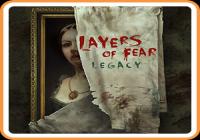Layers of Fear: Legacy (Nintendo Switch) Review
By Renan Fontes  21.02.2018
21.02.2018

Regardless of genre, horror games tend to suffer from one core issue: keeping the experience scary. No matter how frightening a game begins, time will naturally allow players to accustom themselves to the environment, severely limiting the scares that can be pulled off later on. Concurrently, dying too often can lead to an immersion break as resetting a section creates a disassociation where players see danger as an obstacle to overcome rather than a legitimate horror to escape from. With no enemies, no ways to die, and a relatively short playtime, Layers of Fear breaks away from horror's hardest hurdles to deliver an incredibly atmospheric, and terrifying, experience.
"Walking simulator" is a term that gets thrown around quite often in regards to largely atmospheric and story-bade first person titles that implies an inherent lack of quality and while Layers of Fear: Legacy can be called a "walking simulator," it's hardly indicative of the sheer amount of quality present in the title. The gameplay may not be conventional, and there's never any real danger, but all that simply means is more time spent on crafting the story and refining the atmosphere.
Isolated in an artist's old home, the story's progression can feel like a walking tour of the house where each room offers new context for making sense of the backstory. Much of the gameplay is spent simply walking around, finding scattered notes or keys strewn about, and solving puzzles. The need for constant attentiveness creates a scenario where the player slowly adjusts to the home's layout, recognizing patterns and learning how to approach new scenarios. Forcing the gameplay to go slow develops the skills necessary to tackle the puzzles later on, ensuring no one ever gets too far without understanding exactly what's expected of them.

Each chapter is paced well, with no one section dominating the entire game. Chapters consist of 20 to 25 minutes areas where the Artist must explore his home and find puzzles to solve before finding the next piece of his painting. While most of the content in each chapter revolves around exploring the house, there's never a need to sit down and process the architecture of the mansion. Rooms are constantly disappearing or shuffling around. The more the manor is explored, the more manic it becomes. Minor changes in the setting slowly start to incorporate vile imagery as subjects in paintings are lynched and rat corpses begin to appear with a frequency. The gradual disorientation of the setting strips away the safety of familiarity to craft an environment that keeps players on their toes.
The story is primarily told through reading notes left around the house or picking up an item that triggers one of the Artist's memories. Voice acting is primarily only used during these memory sequences where either the Artist or his wife deliver a quick line or two to hint at what the item might represent in the greater narrative. As these moments are rare and tend to reveal the story's more intimate details, it's nice to see that the voice direction is of a fairly high quality. The Artist and his wife are both voiced by clearly capable performers who deliver some genuinely chilling performances in the second half. It certainly helps to have a strong script, of course. The actual writing is great all around. Questions are never raised without the answer close following, but the answers are never so apparent where the mystery loses all its appeal. Very little is explicitly defined within the plot, but there are several allusions and hints that illuminate the Artist's house life.

At the core of Layer of Fear is a family drama. The Artist is obsessed with his work, his wife is becoming increasingly displeased with him, and they're raising their young daughter together. As the game opens with a sombre, yet relaxing, musical piece, it's easy to get lost in the introduction thinking that there won't be any scares. For a while, actually, this feels like the case. Most scary moments up until the end of the first chapter are light jump scares. Rooms and paintings change around a bit, but never so supernaturally where it breaks the grounded tone of the opening. Once the first chapter is complete, however, the house starts to take on more hostile elements, transitioning from a relaxed atmosphere to a chilling one.
Every chapter manages to expand on the overall narrative while also picking a theme and sticking to it. Puzzles, notes, and the explored rooms take on similar elements within each section, giving the story a clear series of act breaks. It's relatively minor, but breaking up the plot like this allows for the pace to flow naturally without needing to waste time on new exposition. The house is constantly changing its layout so there's no need to waste time detailing how and why the Artist is tackling the house. It's certainly unconventional for a game that emphasizes exploration to downplay exploration, but it only serves to help the plot keep moving.
Thanks to a lack of enemies, there can be a noticeable absence of danger early on. If there's no way to die, there's no reason to be afraid. That train of thoughts is quickly broken down, however. All the lack of death means is that the Artist is forced to endure everything thrown at him. In most horror games, death can be a way to regroup and recompose. Death naturally breaks the immersion, but removing death keeps the immersion intact. There's no way to fail, but there's also no way to escape set pieces. Every step further into the mansion is a commitment to confront any horrors along the way.

Layers of Fear does a great job balances the types of scares in its arsenal. Jumpscares occur relatively frequently, but they tend to lack the traditional scare chord associated with them, resulting in subdued jumpscares that establish a tone more than anything. Most of the other horror is purely psychological. Dead rats appear in random locations, baby dolls fade in and out of existence, and paintings are mangled beyond recognition. Trusting the house becomes difficult, and every new room resets the potential for fear. Some of the images can be deeply unsettling, especially with an understanding of the story.
Inheritance, the DLC sequel, is included in Legacy and, while it doesn't feel entirely necessary, it shines new light on the Artist and his wife. The DLC takes place years after the original, swapping control from the Artist to his daughter. The gameplay is far more subdued, giving an incredible amount of attention to exploring rather than puzzle solving. It's also easily clearable in an hour, but it's a welcome epilogue nonetheless.
Unfortunately, there are some technical issues that hold Layers of Fear: Legacy back. The frame rate tends to dip during particularly active moments, and there's minor stuttering throughout most of the game. Inheritance has a fair share of glitches, as well, with one that even requires exiting to the main menu and restarting to progress. These problems are disappointing, especially since so much of the experience relies on immersion, but they aren't enough to severely damage the whole product. The story is legitimately gripping, and psychological horror is strong enough to endure a weak performance. That alone is more than enough to make for a highly satisfying horror experience.

Cubed3 Rating
Great - Silver Award

Despite some technical issues, Layers of Fear: Legacy manages to weave together an incredibly intimate, and tense, family drama that can scare just as effortlessly it can intrigue. Each new setting and puzzle reveals a piece of the overarching narrative through an eerie atmosphere that blends perfectly with the haunting score. There's never a dull moment as each chapter has its own defined feel to distinguish it from the rest of the game. Scares come fast, but almost always psychologically, slowly raising the tension as the story comes to a close. Layers of Fear: Legacy may stutter at times, but it's easily one of the best horror titles on the market.

![]() 8/10
8/10
![]() 0
(0 Votes)
0
(0 Votes)
 Out now
Out now  Out now
Out now  Out now
Out now  Out now
Out now Comments
Comments are currently disabled

 Sign In
Sign In Game Details
Game Details Subscribe to this topic
Subscribe to this topic Features
Features






 Top
Top

